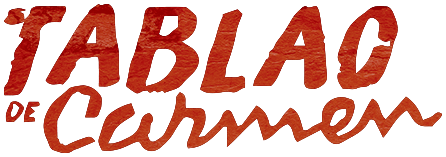CARMEN’S BLOG by EVA BLANCH
Many customers come to the Tablao de Carmen not having a clear idea of what it is they are going to see. They expect a show with a story, a beginning that develops to a climax and leads to an ending. They imagine that all of this will be accompanied by a choreography adapted to the show. Like a theatre function: a kind of Spanish folkloric opera or musical.
This preconception has nothing to do with what our flamenco show truly is.
The “palos” of flamenco
The first thing one must know about flamenco is that it is a musical form that is divided into “palos.” Each palo has a different variety of rhythm. The three best-known palos are the alegría, the soleá and the seguiriya, but many more exist: almost fifty. There are joyful, faster palos that are perfect for starting a show. Others are more dramatic, slower and need more concentration from the artists and are better suited to close the show.
The structure of a flamenco show
In a traditional tablao, the flamenco show is a series of palos represented by a number of artists. Each act is independent from the one that precedes it and the one that follows. Each palo expresses something, a sentiment, an emotion that is framed by the chords of the guitar, the gestures of the dancer, the heal tapping and rhythm keeping of the other artists and by the chosen moments of silence.
By means of the different palos, the show flows through a series of rhythms and emotions. The climax is more joyful when we are in the alegría, more dramatic with the seguiriya and more soothing when we hear a guitar solo.
The house’s “cuadro” flamenco
The group of artists that regularly perform at a tablao are referred to as the “cuadro de la casa,” or the house’s “cuadro.” These are the guitarists, dancers, artists who clap the rhythm of the palo and singers. Every night is different, because this is the way the flamenco wants it. There is an inevitable dose of improvisation and flexibility. Every day the dancers are assigned their palos. It is possible that one of the artists will not be in the right state of mind for a determined palo. The flamenco needs to feel the sentiment of the dance, and this is not a mechanical process. But thanks to a familiar atmosphere and established organic order, the artists are able to coordinate with each other to determine and define the tone and rhythm of the show.
The Tablao de Carmen and other tablaos
One of the things that defines the Tablao de Carmen is the will to maintain the atmosphere and essence of a pure flamenco show. All that was previously explained is upheld here with a great deal of tenacity and effort, and is the fundamental to the Tablao de Carmen.
On top of this, our space is designed to bring the spectators closer to the artists, keeping from the distance created in a traditional theatre, searching for a sense of togetherness between the artists and recreating the atmosphere of the “singing cafes” of the glorious epoch of flamenco in Barcelona. And just as it was back then, spectators drink and dine at tables as the show unfolds.
The flamenco “fin de fiesta”
The quintessential flamenco palo which signals and marks the end of the show is the bulería. This is a joyful palo that welcomes the spirit of celebration, the final bout of joy where there is a great deal of improvisation, where all the artists take the stage to celebrate the end of the show. Sometimes children, mothers, uncles or grandparents that have been present as spectators to the show, relatives or friends who know a great deal about flamenco or younger aspiring artists, will take the stage. In these cases an almost magical atmosphere is created; we begin to feel we are also a part of the intimacy of these families. It is as though we are in a wedding or a birthday or a christening, one of the situations which are the origin and the essence of this great art.
